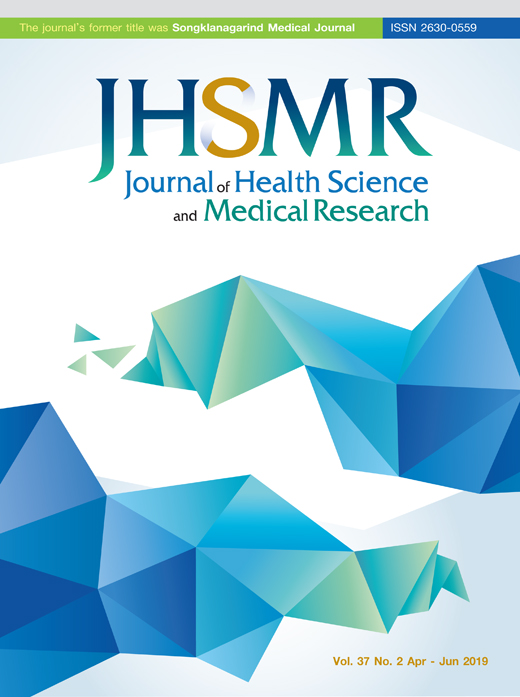Prevalence of Atypical Disorders and Associated Factors in Undergraduate Students of Prince of Songkla University, Songkhla, Thailand
DOI:
https://doi.org/10.31584/jhsmr.201947Keywords:
BMI, eating attitudes, eating behaviors, undergraduate studentsAbstract
Objective: To quantify the prevalence of eating disorders and factors associated with eating disorders among undergraduate students in Prince of Songkla University, Hat Yai Campus.
Material and Methods: This study was a cross sectional descriptive study using random sampling by proportionate accidental sampling. We used the Thai Eating Attitudes Test-26 (EAT-26) for collecting information about eating attitudes. Participants who had scores equal or higher than 12 (≥12) were assumed to have atypical eating attitudes and behaviors. We used the R and R studio program to analyze information. Multivariate logistic regression was used for correlation analysis.
Results: In this study, we had completed questionnaires from 500 students (response rate 65.6%). The overall prevalence of atypical eating attitudes and behaviors in undergraduate students in Prince of Songkla University, Hat Yai Campus was 37.2%. We found that overweight body mass index (BMI) (BMI 23.00-24.99 kg/m2) and obesity BMI (≥25.00 kg/m2) were significantly more prevalent in students with atypical eating attitudes and behaviors than normal BMI (18.50-22.99 kg/m2), with odds ratios of 3.3 [95% confidence interval (CI)=1.8-6.2] and 3.7 (95% CI=1.9-6.9), respectively. However, multivariate logistic regression revealed no associations between atypical eating attitudes and behaviors, sex, target weight, biological disease, psychological disease, current medication(s) or faculty. Atypical eating attitudes and behaviors were significantly associated only with body mass index BMI. The overweight and obese BMI groups had significantly increased risks of 3.3 and 3.7 times of atypical eating attitudes and behaviors compared to the normal group, with 95% CIs of 1.8-6.2 and 1.9-6.9, respectively.
Conclusion: From this study, overweight BMI and obesity BMI were significantly more prevalent in students with atypical eating attitudes and behaviors than normal BMI. BMI was the only factor significantly associated with atypical eating attitudes and behaviors.
References
2. Martin A, Volkmar FR. Lewis’s child and adolescent psychiatry. a comprehensive textbook. 4th ed. Philadelphia: Lippincott, Williams & Wilkins; 2007;p.592-601.
3. Olden K, White L. Health-related disparities: influence of environmental factors. Med Clin North Am 2005;89:721-38.
4. Westmoreland P, Krantz MJ, Mehler PS. Medical complications of anorexia nervosa and bulimia. Am J Med 2016;129:30-7.
5. Thomas JJ, Lee S, Becker AE. Updates in the epidemiology of eating disorders in Asia and the Pacific. Curr Opin Psychiatry 2016;29:354–62.
6. Mustelin L, Bulik CM, Kaprio J, Keski-Rahkonen A. Prevalence and correlates of binge eating disorder related features in the community. Appetite 2017;109:165-71.
7. Pitanupong J, Jatchavala C. Atypical eating attitudes and behaviors in Thai medical students. Siriraj Med J 2017;69:5-10.
8. Garner M, Garfinkel E. The Eating attitude test; an index of the symptoms of anorexia nervosa. Psychol Med 1979;273-9.
9. Mintz L, Halloran M. The eating attitude test. Validation with DSM-IV eating disorder criteria. J Pers Assess 2000;74:489-503.
10. Kaewpornsawan T, Pornjira Pariwatcharakul P, Pimratana W. Criterion validity study of Eating Attitudes Test-26 (EAT-26 Thai Version) among Thai females. HMJ 2013;58:283-96.
11. Areemit R, Patjanasoontorn N. Anorexia nervosa in a Thai adolescent. Eat Weight Disord 2012;17: 207-9.
12. Pattanathaburt P, Somrongthong R, Thianthai C. Prevalence of disordered eating behaviors, body image dissatisfaction, and associated factors among Thai female undergraduate students. J Health Promot Educ 2013;51:151–60.
13. Winijjakul T. Social media and eating disorder [homepage on the Internet]. Bangkok: She Academe; 2016 [cited 2017 Nov 10]. Available from: https://sheacademy.in.th/?p=694
14. Health System Research Institute. Healthy survey in Thai population 2014 [monograph on the Internet]. Bangkok: Health System Research Institute; 2014 [cited 2017 Nov 20]. Available from: https://www.hsri.or.th/researcher/research/newrelease/detail/7711
15. Chang W, Nie M, Kang W, He P, Jin L, Yao S. Subclinical eating disorders in female medical students in Anhui, China: a cross-sectional study. Nutr Hosp 2015;31:1771-7.
16. Lipson K, Sonneville K. Eating disorder symptoms among undergraduate and graduate students at 12 U.S. colleges and universities. Eat Behav 2017;24:81-8.
17. Tyler M, Wilkinson A. The tyranny of corporate slenderness:‘corporate anorexia’ as a metaphor for our age. Work Employ Soc 2007;21:537-49.
18. Myers A, Rosen JC. Obesity stigmatization and coping: relation to mental health symptoms, body image, and selfesteem. Int J Obes Relat Metab Disord 1999;23:221-30.
19. American Academy of Child and Adolescent Psychiatry. Obesity in children and teens [homepage on the Internet]. Washington: American Academy of Child and Adolescent Psychiatry; 2016 [cited 2017 Nov 10]. Available from: https:// www.aacap.org/aacap/families_and_youth/facts_for_families/fff-guide/obesity-in-children-and-teens-079.aspx
20. National Eating Disorder Association. Males and eating disorder: research [homepage on the Internet]. New York: National Eating Disorder Association; 2012 [cited 2017 Aug 11]. Available from: https://www.nationaleatingdisorders.org/sites/default/files/ResourceHandouts/ResearchonMalesandEatingDisorders.pdf
21. Tseng MM, Chang CH, Chen KY, Liao SC, Chen HC. Prevalence and correlates of bipolar disorders in patients with eating disorders. J Affect Disord 2016;190:599–606.
























